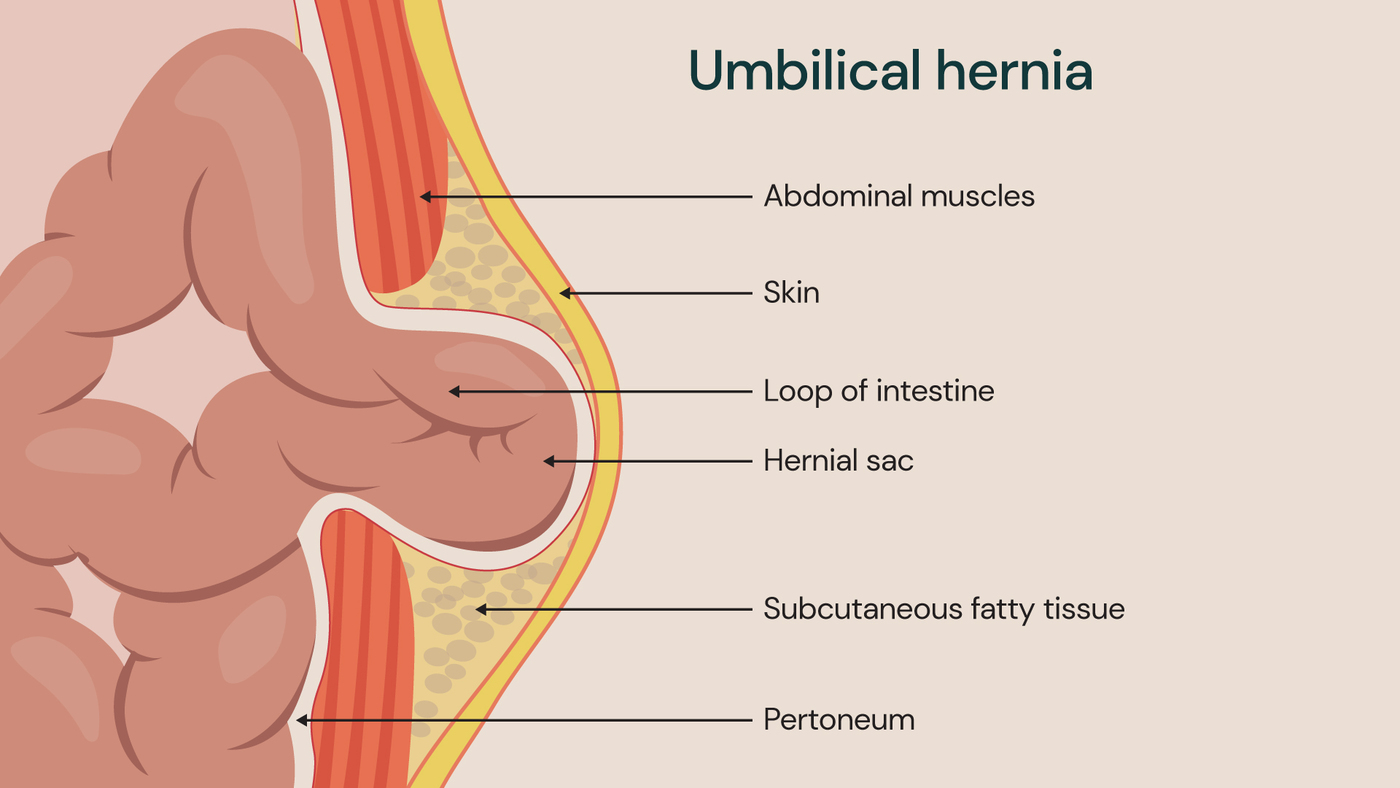Hernia is the term used to describe where an internal part of the body pushes through a weakness in the muscle or surrounding tissues, causing it to be out of place.
Hernias are extremely common — it’s estimated that around 100,000 people in the UK have hernia repair surgery every year.
They are just as likely to affect children as they are adults. In fact, some types of hernia are actually more common in infants and children. Boys are more likely to be affected than girls, with around 1 in 50 boys developing a hernia in childhood.
Our specialist gastrointestinal surgeons treat both adults and children at our hospitals.
How do I know if I have a hernia?
The most obvious symptom of a hernia is an unusual bulge under the skin where the internal tissues are pushing through. Exactly where this will occur will depend on the type of hernia.
It’s important to note that small hernias may not be visible all the time. For example, many umbilical hernias (see below) can only be seen when you are crying, coughing or straining to go to the toilet. This is because these actions cause the stomach muscles to tense, making the hernia easier to see.
Occasionally, a hernia may cause other symptoms depending on the type of hernia that it is. With umbilical hernias children may have a very round stomach, experience pain or touch or rub the area.
Types of hernia
There are different types of hernia and below are some of the more common types:
Umbilical hernias
Umbilical hernias are more common in infants than adults. The condition occurs in the same way, with abdominal tissues bulging through a weakness near the belly button.
During pregnancy, a baby’s umbilical cord will pass through a small opening in their tummy. Shortly after they are born, and the umbilical cord is not needed anymore, the opening should close spontaneously. However, for some babies this doesn’t happen right away and a hernia can develops.

An umbilical hernia
Umbilical hernias appear as a small bulge close to your belly button.
In adults, umbilical hernias may develop due to being overweight or straining while moving or lifting a heavy object. It can also occur in women following childbirth, if they have experienced a separation of stomach muscles during pregnancy (a condition called diastasis recti).
In most cases, umbilical hernias resolve themselves – approximately 90% of children’s umbilical hernias will close by age 5. In older children and adults or if there are symptoms of pain or incarceration, an umbilical hernia will need to be repaired with surgery.
Inguinal hernia
An inguinal hernia is the name given to a hernia that develops in the groin or scrotum. This can happen in babies and children if an opening in the abdominal wall, which is supposed to close before birth, stays open allowing the intestines or other organs to push through.
Inguinal hernias can develop on either side of the groin, but they are more often seen on the right side. For infants they could be at greater risk of an inguinal hernia if they are born prematurely (before 37 weeks of pregnancy).
Inguinal hernias have a higher risk of incarceration (the contents are unable to be pushed back through the opening) so surgical repair will be needed to fix them. It’s a simple, straightforward procedure, which is done under general anaesthesia as a day case procedure, with patients usually returning home the same day.
Epigastric hernia
An epigastric hernia forms when tissues that join the muscles in the upper part of the abdomen haven not formed properly, enabling tissue such as fat to bulge through the gap. Epigastric hernias are congenital, which means that you are born with them.
In many cases, an epigastric hernia doesn’t require treatment unless it starts to cause discomfort and becomes large in size. If treatment is sought, this involves a surgical repair to close the small hole in the abdominal wall muscle. This is usually performed under general anaesthesia as a day case procedure.
Hiatus hernia (diaphragmatic hernia)
A hiatus hernia, also called a diaphragmatic hernia, forms when part of the stomach pushes its way through a weakness in the diaphragm into the chest. Hiatus hernias are rare in children and much more common in adults who are pregnant, overweight or over the age of 50.
This type of hernia does not always need treatment. However, if the child is experiencing symptoms, our gastrointestinal specialists can provide medical management. If medication and lifestyle changes are not possible, hernia repair surgery can be used to resolve a hiatus hernia.
Strangulated hernia
Generally, a hernia is not a serious problem. However, in some cases, it’s possible for the protruding organ or tissue to become stuck in the opening they are pushing through, and this makes it impossible for blood to flow to it. This is known as a strangulated hernia and is a life-threatening condition.
Signs of a strangulated hernia can include severe pain, nausea and vomiting, failure to pass gas and swelling of the abdomen. In this case, urgent surgery is needed to repair the hernia.
How is a hernia diagnosed?
Most hernias are diagnosed by a gastrointestinal specialist assessing your clinical history and doing a simple examination. A consultant will look at and feel the area, checking that the hernia goes back into the body when gentle pressure is applied.
In some cases, an ultrasound scan will be recommended so that they can see the hernia in more detail.
Hernia treatment options
After an initial consultation and examination, our clinicians will advise whether treatment is needed for the hernia.
For both children and adults, the only way to treat a hernia is with surgery. Our team will create a treatment plan tailored to the type of hernia you have.
Hernia repair will be performed using general anaesthetic to close the hole in abdominal wall muscle by open or minimally invasive approach. In many cases, patients may be able to go home the same day.
Some hernia surgeries can be performed laparoscopically. This is a minimally invasive approach that sees the surgery performed through several very small incisions rather than one larger one. It is also referred to as ‘keyhole surgery’.
If surgery is recommended, our expert team will advise you on what you can expect to happen so that you can feel prepared.
How to prevent a hernia?
Although many hernias can’t be prevented, there are things that you can do to help reduce the risk of experiencing complications.
Eat a healthy, balanced diet
Obesity, and health conditions caused by obesity, are some of the main reasons why adolescents and adults develop hernias.
By making sure that you eat a healthy, nutrient-rich diet, you can help maintain a healthy weight and reduce the likelihood that they will develop a hernia.
Exercise
Exercise is great for maintaining a healthy weight too, and regular exercise will help keep muscles strong — something which could prevent hernias.
It can be especially useful for women to strengthen abdominal muscles particularly in preparation for pregnancy, as carrying a child can put a great deal of strain on the abdomen and increase abdominal pressure, making a hernia more likely.
Promoting healthy bowel movements
Straining due to constipation can cause hernias to develop. Eating a good diet with plenty of fibre and fluids can help ensure that you or your child doesn’t suffer from painful constipation and will minimise the risk of having a hernia caused by straining.
Proper lifting techniques
It’s not uncommon for hernias to occur as a result of straining during lifting. It’s a good idea to teach children proper lifting techniques, and practise these yourself, such as bending at the knees rather than using your back. Not only will this potentially prevent injuries, but it could stop you from developing a hernia in the future too.
Locations
Treatment for hernias is available at the following locations:
Discover our gastrointestinal experts
Meet our team of leading gastrointestinal surgeons. Including upper, lower and colorectal treatments our specialists are here to provide you with personalised care.
